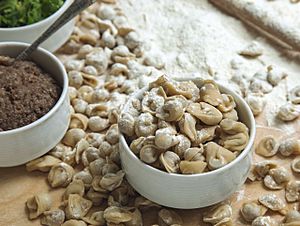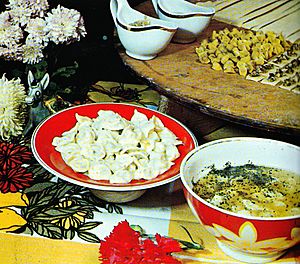Joshpara facts for kids

Düşbərə prepared for cooking
|
|
| Alternative names | chuchvara, chüchüre, chüchpara, düshbärä, shishbarak, shushbarak, tatarbari, tushbera, tushpara |
|---|---|
| Type | Dumpling |
| Region or state | Western Asia, Central Asia |
| Serving temperature | Hot or cold |
| Main ingredients | Dough (flour, eggs, water, salt), ground meat (other than pork), onions, herbs, salt, black pepper |
Joshpara is a tasty type of dumpling that is very popular in different parts of the world. You can find it in Central Asia, the South Caucasus, and the Middle East. These small, delicious bites are made from unleavened wheat dough squares. They are filled with seasoned ground meat. Because of Islamic dietary laws, the meat filling usually does not include pork.
Contents
What's in a Name?
The name Joshpara has an interesting history. Josh means "to boil" and para means "bit" in old Persian. This name was used a long time ago, before the 10th century. Later, it was replaced by a new Persian name, gosh e-barreh, which means "lamb's ear." This name describes the shape of the dumpling.
You'll find many different names for this dish in other languages. For example, it's called düşbərə in Azerbaijani and tushpara in Kazakh. In Kyrgyz, it's chuchpara, and in Tajik, it's tushbera. The Uzbek name is chuchvara, and Uyghur people call it chöchürä. The Arabic name shishbarak is also thought to come from joshpara.
Some people believe the name comes from the Turkic word düşbərə. In this idea, tosh and dash mean "filled up" and "spill out." Berek means "food" made from dough. This name might describe how the dumplings are added to boiling water that is spilling over.
There's a funny joke in Azerbaijan about the name. It suggests that düşbərə comes from “düş bəri”, which means "fall here." This is like asking to fill your spoon with as many of these tiny dumplings as possible!
How Joshpara is Made Around the World
Central Asian and Persian Styles
You can find this dish in many cuisines, like Azerbaijani, Iranian, Tajik, Uzbek, and Uyghur food.
For chuchvara or tushbera in Central Asia, the dough is made with flour, eggs, water, and salt. It's rolled out very thin and cut into small squares. A small amount of meat filling is placed in the middle of each square. This filling has chopped onions, black pepper, salt, and thyme. The corners of the dough are then pinched together to seal the dumpling.
These dumplings are boiled in meat broth until they float to the top. You can eat chuchvara in a clear soup or by themselves. People often add vinegar or a special sauce made from chopped greens, tomatoes, and hot peppers. Another popular way to enjoy chuchvara is with syuzma (a type of strained yogurt) or smetana (sour cream). The sour cream version is sometimes called Russian-style.
In Azerbaijan, the dumplings are usually smaller, and the dough is a bit thicker. Düşbərə is typically made from dough (flour, egg, water) and a filling of mutton (lamb meat without bones), onions, and spices. Sometimes, beef or even chicken is used instead of mutton. The broth is often made from mutton bones.
To make them, the dough is rolled out and cut into tiny squares. Each square is filled with the ground meat mixture. Then, the squares are folded into triangles, and the edges are sealed. This makes them look like tiny seashells. The dumplings are cooked in boiling salty water until they float. Düşbərə is served with dried mint sprinkled on top. Many people also add vinegar mixed with shredded garlic for extra flavor. A spoon can usually hold 5 to 8 düşbərəs. But in some rural areas, they are made so small that you can fit as many as 20 on one spoon!
Middle Eastern Styles
Shishbarak is a similar dish found in countries like Iraq, Jordan, Lebanon, Palestine, Syria, and parts of Saudi Arabia. Here, thin dough parcels are filled with ground beef and spices. Instead of broth, these dumplings are cooked in yogurt and served hot in their creamy sauce. Shishbarak has been a part of Arab cuisine for hundreds of years. A recipe for shushbarak even appears in a 15th-century Arabic cookbook from Damascus.
Other Similar Dishes
- Finnic peoples in Western Siberia learned about a similar dish from Iranian traders long ago. They called it pelnan, which means "ear bread." This dish later became popular in Russia in the 17th century and is now known as pelmeni.
- Manti is another type of dumpling that is very popular in Central and Western Asia.




